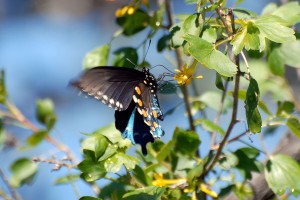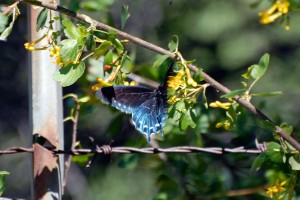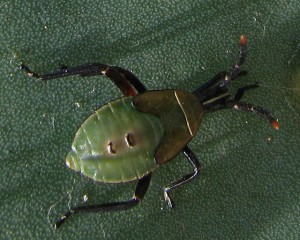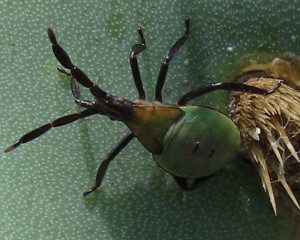We have two new additions to the BFS Inverts list:
- The Pipevine Swallowtail, Battus philenor. The larvae of this striking black and blue iridescent butterfly feed exclusively on Aristolochia species, including “Pipevine” or “Dutchman’s Pipe.” The adults sip nectar from a number of different flowers — this one was seen on Golden Current, Ribes aureum. The Pipevine Swallowtail flutters its wings incessantly while nectaring, as you can see from the blur in these photos:
No pipevines grow at the BFS, but one (Aristolochia californica) does grow at the adjacent Rancho Santa Ana Botanic Garden, and this butterfly was spotted along the fence between BFS and the Garden. The larvae take up toxic compounds from the pipevine host, and both the adults and older larvae are toxic to predators.
The butterfly seen at the BFS is the Arizona subspecies. The northern California subspecies’ range only extends south to San Luis Obispo.
- Cactus Coreid, Chelinidea vittiger. Resembling the more familiar squash bug, the Cactus Coreid is common on Prickly Pear cactuses through most of the US and into northern Mexico. Cactus Coreids pierce the cactus pads and suck up sap. They may inject digestive enzymes or possibly microbes and usually leave a gray-brown, dime-size scar.
Update: Here are some photos of Chelinidea vittiger:
These nymphs were photographed by Harsi Parker at the Rancho Santa Ana Botanic Garden on June 17, 2009. They were inhabiting a patch of Opuntia cactus in the desert garden area near the entrance.
Cactus Coreids have been investigated as possible biocontrol agents in Australia, where exotic prickly pear cacti rendered 30,000,000 acres of pasture land unusable; however, it was not found to be effective for prickly pear control. It’s thought that in areas where prickly pear occurs naturally it’s kept under control by a complex of many insects.
Many thanks to folks at the Rancho Santa Ana Botanic Garden, especially Bob Allen, Michael Wall, and Joan McGuir, for information about the Pipevine Swallowtail and Aristolochia, to Paul Stapp, Cal State Fullerton for spotting the Cactus Coreid, and to Harsi Parker for the Cactus Coreid photos.
References and More Information:
- Species Battus philenor – Pipevine Swallowtail – Hodges#4157, BugGuide.net.http://bugguide.net/node/view/412
- Species Chelinidea vittiger – Cactus Coreid, BugGuide.net. http://bugguide.net/node/view/24815
- Cactus Bug – Chelinidea vittiger, Sonoran Desert Naturalist. http://www.arizonensis.org/sonoran/fieldguide/arthropoda/chelinidea_vittiger.html
- Mead, F.W., and J.L. Herring. 2005. Cactus Bug, Chelinidea vittiger aequoris McAtee (Insecta: Hemiptera: Coreidae). Publication Publication #EENY208, Entomology and Nematology Department, Florida Cooperative Extension Service, Institute of Food and Agricultural Sciences, University of Florida. http://edis.ifas.ufl.edu/in365




